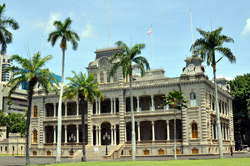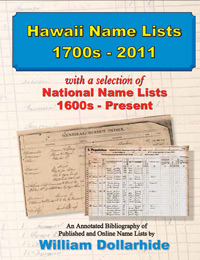The following article is excerpted from Bil Dollarhide’s New Book, Hawaii Name Lists, 1700s – 2011.
For genealogical research in Hawaii, the following timeline of events should help any genealogist understand the area with an historical, jurisdictional, and genealogical point of view:
1627. The first Europeans to see Hawaii were aboard Spanish sailing ships. In 1627, one Spanish ship captain described a volcanic eruption in his ship’s log, the first known recorded mention of the islands. Polynesians had been there for centuries, with considerable evidence that the earliest Hawaiian villages date back to 300 A.D. and Polynesian folklore describes their earliest settlers coming by outrigger canoe from Tahiti.
1778. January. On an expedition to China, British explorer Captain James Cook discovered the present Hawaiian Islands. He named them the Sandwich Islands after the Earl of Sandwich, one of the expedition’s sponsors. Cook went on to Alaska to look for the Northwest Passage and mapped the northern Pacific Ocean so accurately that his maps were used for 100 years. After his Alaska venture, Cook then returned to the Hawaiian Islands in November.
1779. February. Captain Cook visited the Big Island. After one of his ship’s dinghies was stolen, Cook decided to kidnap the local chief to get it back – but his plan failed. He was killed in the resulting battle.
1785. The first French ships, the frigates Boussole and Astrolabe visited Hawaii, under the command of Jean-Francois de Galaup de La Pèrouse. (See the Chart of the Sandwich Islands, p. HI-2).
1789. The first American ship landed in Hawaii. Captain Robert Gray, in his ship Columbia, was on his first voyage to the south seas. Gray was hailed as the first American to circumnavigate the world, and for his discovery of the Columbia River in 1792, named after the same ship he had used to visit the Sandwich Islands.
1792-1794. British Captain George Vancouver, after meeting with American Captain Robert Gray, and learning the location of the newly discovered Columbia River, sent an expedition up the river for the first time. He also explored the present Oregon and Washington coasts, Puget Sound, and the largest island on the western side of North America, which he named after himself. Vancouver’s visit with Gray also led to his decision to visit Hawaii. After his Pacific Northwest discoveries, Vancouver took his three ships to the Sandwich Islands. He became a personal advisor to Kamehameha, brought gifts, including the first longhorn cattle introduced to Hawaii. In 1794, Vancouver declared the Sandwich Islands as a protectorate of Great Britain.
1795-1854. Through conquest, King Kamehameha I (1795-1819) unified the Hawaiian Islands into one kingdom. A charismatic leader, he and his sons, Kamehameha II (1819-1824) and Kamehameha III (1825-1854) were to change the cultural rules of the Hawaiian society, such as eliminating Kapu restrictions on class distinctions and the subjugation of women. The kings also refused to worship the ancient Polynesian gods, and told their people the gods were not real. For the first few generations under unified rule, the Hawaiian natives were open to just about any religious experience, and accepted the Europeans and Americans soon to arrive in great numbers to exploit the natural wonders and climate of the islands.
1821. Protestant missionaries arrived. Many Hawaiians were converted to Christianity. In just ten years, the protestant leaders, mostly strict New England Congregationalists, dominated the religious scene, and were able to prevent other religious groups from getting a foothold in the Islands.
1831. Catholic missionaries from France that had arrived during the late 1820s were forced to leave or be imprisoned in 1831.
1835. The first sugar plantation was established on Kauai Island.
1839. Roman Catholics received religious freedom after the Islands were threatened by French warships. To avoid war, Kamehameha III paid reparations to France for the deportation of Catholic priests. But just a few years later, the French learned that their missionaries were still not being treated very well.
1840. Hawaii adopted its first constitution, moving from a Feudal Society to a Constitutional Monarchy. It gave religious freedom to subjects, and let commoners own their own land. The constitution called for all land to be divided between the King and Island Chiefs, which could then be sold to the people.
1842. A legislative and judiciary government was established within a limited monarchy. The first House of Representatives was called to order. Also in this year, the first class began at Punahou, the new private school. And, Kamehameha III began sending emissaries to the U.S., France, and England to secure recognition of an independent and sovereign Hawaiian government. President John Tyler gave his assurance in writing in December 1842, and in March and April 1843. Hawaiian Independence was assured in writing by King Louis-Philippe of France and Queen Victoria of Great Britain.
1843. In February, two months before Queen Victoria’s statement supporting the ”Independence of the Sandwich Islands,” Lord George Paulet moved the British warship HMS Carysfort into Honolulu Harbor and demanded that King Kamehameha III cede the islands to the British Crown. The King reluctantly agreed, but Paulet’s action enraged the French and Americans, who were able to get Paulet’s boss, Rear Admiral Richard Thomas to Honolulu in July. Thomas apologized for Paulet’s actions, and restored Hawaiian sovereignty. In November 1843, at the Court of London, the British and French Governments formally recognized Hawaiian independence. John Tyler’s 1843 statements of support were not formally confirmed by the U.S. Congress until 1849.
1848. A law passed that divided all of the land of all islands between King Kamehameha III and his Island Chiefs. Most of the chiefs gave their land to the government, which in turn sold land to the Hawaiian people.
1849. In August, French forces arrived in Honolulu Harbor demanding full religious rights for their Catholic missionaries. They stormed the harbor fort, and did considerable damage, but left Honolulu a month later. King Kamehameha III basically ignored the French and their demands.
1852 June. The first steam-powered ship arrived in Hawaii from San Francisco. One of the passengers on board was a young man identified only as “Mr. Dollarhide.” Later that year, the same steamship was the first one used in inter-island service.
1853. A smallpox epidemic took the lives of over 5,000 Hawaiians.
1854-1863. The reign of King Kamehameha IV. He was a nephew and adopted son of Kamehameha I. He was not in favor of an American annexation of the Hawaiian Islands, being more fond of the British culture than that of the Americans.
1863-1872. King Kamehameha V reigned. He was an older brother of Kamehameha IV, and was much respected by the Hawaiian people for his devotion to Hawaiian culture and restoration of Hawaiian medical practices. Mark Twain once spent four months in Hawaii in 1866, and wrote extensively about the islands. His comments about King Kamehameha V: “He was a wise sovereign; he had seen something of the world; he was educated and accomplished; he was popular, greatly respected, and even beloved.”
1865. The first wave of immigrant plantation workers departed from Yokohama, Japan, for Hawaii.
1872-1874. After Kamehameha V died without an heir in 1872, his cousin was elected King Lunaliho in 1873, but died a year later.
1874-1891. During the reign of King Kalakua, many Hawaiian customs that had been discouraged by earlier rulers became popular again. He became known as the “Merry Monarch.”
1875. King Kalakaua went to Washington, DC, visited President Ulysses S. Grant, and signed a treaty with the U.S. allowing Hawaiian sugar and rice to enter the U.S. tax-free.
1878. The first telephone was in operation, two years after Alexander Graham Bell’s patent.
1879. The first steam locomotive pulled its first train load of sugarcane on Maui.
1882. The Iolani Palace was first occupied by the Hawaiian royalty. Two monarchs governed from the Iolani Palace: King Kalakaua and Queen Liliuokalani. After the monarchy was overthrown in 1893, the building was used as the capitol building for the Provisional Government, Republic, Territory, and State of Hawaii until 1969. The palace was restored and opened to the public as a museum in 1978.

1883. Electricity arrived as five arc lamps were strung around Iolani Palace. This was also the year of the Great Chinatown Fire, with losses exceeding $1,455,000.
1887. To enhance trade with the United States, King Kalakaua allowed them exclusive use of Pearl Harbor as a naval base.
1890s. Several U.S. and European settlers had begun planting pineapples. Sugarcane planting also became an important industry. Thousands of workers were needed for these plantations; many came from China, Japan and the Philippines.
1891. Upon the death of King Kalakaua, his sister, Lydia, became Hawaii’s only ruling queen and last Hawaiian monarch. As Queen Liliuokalani, she tried to maintain Hawaii’s culture against the large influx of Americans and Europeans who by now controlled the economy.
1893. In a trumped up revolution, Queen Liliuokalani was overthrown, ending the 98-year-old Royal Kingdom of Hawaii. A Provisional Government was established, led by Sanford B. Dole and Lorrin A. Thurston. The Queen remained an important influence among the Hawaiian people. Over the next few years, she was successful in convincing President Grover Cleveland that an annexation of Hawaii to the United States should not take place without the approval of the Hawaiian native population. Those U.S. Congressmen in favor of Hawaii’s annexation to the U.S. found that they would have to wait until Grover Cleveland was out of office.
1894. The revolution brought forth the American and British inspired Republic of Hawaii, sometimes called “Dole’s Republic,” which functioned as a recognized nation in the world community for four years. Sanford B. Dole served as the President of the republic.
1898. July. The Hawaiian Islands were annexed to the United States by means of a joint resolution of Congress, called the Newlands Resolution. Sanford B. Dole continued as the President of the Provisional Government until the Hawaiian Organic Act of 1900 established a permanent territorial government led by a governor.
1900. Hawaii became a U.S. territory. Sanford B. Dole was appointed the Governor of Hawaii Territory by President William McKinley, taking office on 14 June 1900. The federal census of 1900 was taken with a census day of 1 June 1900, and Hawaii was included. Population: 154,001. No counties existed yet, and the census was divided into five districts for 1) Hawaii Island, 2) Kauai and Nihau Islands, 3) Maui, Kahoolawe, and Lanai Islands, 4) Molokai Island, and 5) Oahu Island.
1901. The Hawaiian Pineapple Company (now Dole) was established.
1905. Five counties were created by the territorial legislature: Hawaii, Honolulu, Kalawao, Kauai, and Maui. There have been no new counties or changes since 1905. Kalawao County comprised only the Kalaupapa Leper Colony on Molokai Island. The county stills exists, although the entire area is now a National Historical Park. The 90 (or so) permanent residents of Kalawao County do have one officer, a Sheriff, appointed by the U.S. National Park Service.
1910 Federal Census. Population of Hawaii Territory: 191,874
1920 Federal Census. Population of Hawaii Territory: 255,881.
1930 Federal Census. Population of Hawaii Territory: 368,300.
1934. President Roosevelt was the first U.S. President to visit Hawaii.
1940 Federal Census. Population of Hawaii Territory: 422,770.
1941. After the historic Japanese bombing of Pearl Harbor and Oahu on Dec. 7, 1941, the United States declared war on Japan and entered World War II.
1959. August 21. Hawaii became the 50th state to enter the Union.
2011. The population of the State of Hawaii in mid-2011 was estimated by the Census Bureau as 1.4 million people. About one million people were living on Oahu Island, also known as the City and County of Honolulu.
To learn more about Bill Dollarhide’s new Hawaii Name Lists, 1700s – 2011 volume, click on the following links:
Hawaii Name Lists, 1700s – 2011, With A Selection Of National Name Lists, 1600s – Present
